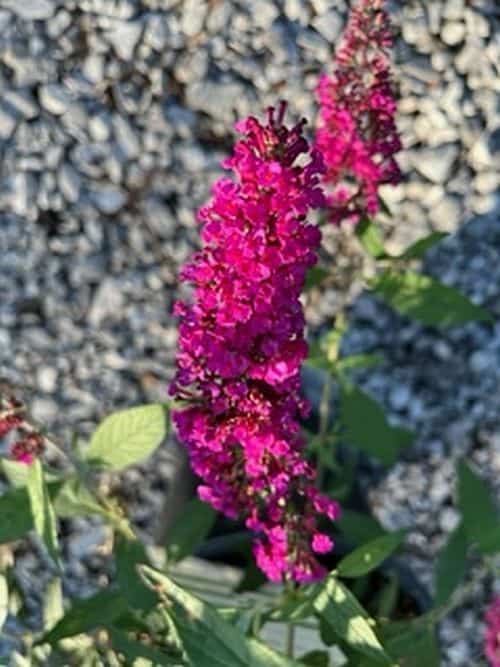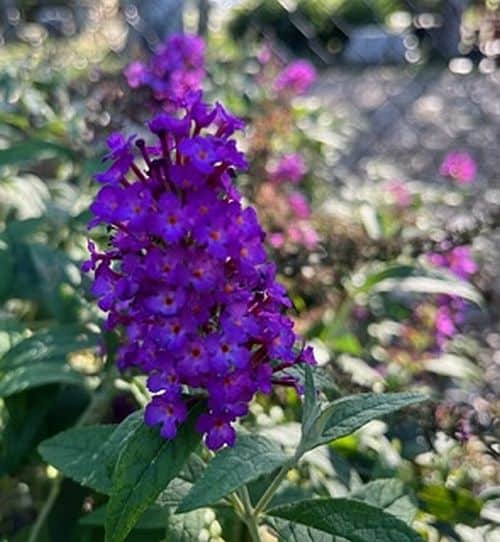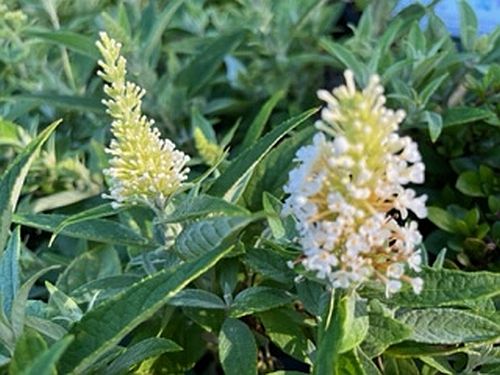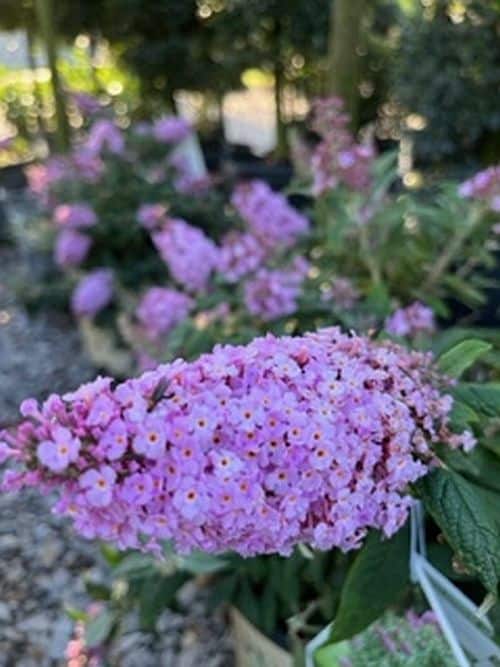Buddleia aka Butterfly Bush for Pollinators
According to the National Wildlife Federation, pollinators are responsible for one of every three bites of food that we eat. We can help pollinators by planting native and non-invasive plants that produce both pollen and nectar to attract not just bees and butterflies, but also hummingbirds, small mammals, bats, small birds and many other animal species. There are hundreds of thousands of species of animal pollinators. You can create a pollinator-friendly habitat by planting native plants and use cultivated ornamentals. Try using ones that are not very aggressive or spread too easily.
I was at a local garden center this past week and like many of our pollinator friends, I was attracted to the various Buddleia with beautiful colors and names like Tutti Fruitti, Hot Raspberry, Pugster Pinker (Dwarf bush), Pink Delight, Buzz (Purple & Velvet), Butterfly Candy (Lil Coconut & Lil Lavender).
Butterflies visit Butterfly Bushes to sip nectar but they’re not a food source for caterpillars. Find out what kinds of butterflies are in your area, grow plants that their caterpillars will eat, and they’re will be in your garden as they go through the different stages of their life cycles.
A butterfly weed (Asclepiadaceae, in the milkweed family) isn’t the same as a butterfly bush, although butterflies are attracted to its bright orange flowers. While they attract butterflies, hummingbirds, and other pollinators, butterfly bushes are resistant to deer, drought, and heat. Butterfly bushes are considered invasive in some parts of the country. Check with your local extension service to be sure you can plant them in your area or look for non-invasive or seedless types.

Buddleia Buss ‘Velvet’
It is best to plant them in early spring or fall although, Buddleia may be planted in mid-summer but will need to be kept well-watered. Give your butterfly bushes six to eight hours of full sun. You may get fewer flowers, but full sun produces strong stems and tall plants won’t need staking. Choose a well-drained, site, moist soil with average fertility. They require a pH of 5.5 to 8.5, and most garden soils range from 6.0 to 7.0, so native soils are usually fine. If needed, mix some good organic compost into clay soil to improve its drainage, or add topsoil, peat moss, or compost to keep very sandy soil from draining too fast. Amendments aren’t usually necessary otherwise. Dig a hole two or three times the diameter of the plant’s root ball and place it in the hole no deeper than it was at original pot level. Backfill the hole and gently firm down the soil to remove any air pockets. Water thoroughly, mulch with a couple of inches of pine straw or shredded bark to discourage weeds. Don’t let the mulch touch the stems as they may cause rot. Butterfly bushes can tolerate some drought once they’re established but need consistently moist soil. When you water, water deeply, but avoid overwatering. Give them a balanced granular fertilizer in the spring, following the label directions for how much to apply, and water thoroughly.
An island bed planted with a butterfly bush (or several) will help attract pollinators. Other places to use them include perennial beds and borders and cottage or wildlife gardens. Container-grown Buddleia need moist, well-drained soil. Use a good-quality potting mix and a container with drainage holes. Choose a container 8 to 10 inches wider than the plant’s root ball so it can grow for a couple of years before it needs repotting.
Invasive varieties of butterfly bush spread easily without propagation. Seedless varieties of butterfly bush cannot be propagated by seed. To propagate a non-patented variety of seedless butterfly bush, use stem cuttings from summer growth as this is the best method. To propagate: Cut a 4- to 6-inch segment from a healthy, sturdy new branch. Remove the leaves from the bottom third of the branch cutting and dip in rooting hormone powder. Plant in a small pot of moistened potting soil. Cover the pot with a plastic bag to hold in moisture and place it in a sunny spot out of direct sunlight. When roots develop in three to six weeks, transplant to the garden or a larger container.

Buddleia Buzz Purple
According to an article by Allen Owings, retired, LSU horticulturist at Hammond Research Center, Butterfly bushes are becoming available in an increasing array of sizes, flower colors, and foliage characteristics. New varieties have been released over the past 10 years. Buddleias can be used as cut flowers and have fragrant blossoms. They are winter hardy in Louisiana, although they can also be used as annuals for color in the landscape if desired. Buddleia flower colors have traditionally been in shades of white, pink, purple and similar colors. A few light yellows have been available. Newer varieties have added new colors to the palette. Other buddleia breeding and selection programs have produced plants with such characteristics as larger flowers, improved growth habit, dwarf forms, self-cleaning, bicolored flowers, double flowers, spider mite resistance and improved foliage variegation.
The most striking and best landscape butterfly bush in the large group of Flutterby series buddleias is the Flutterby Petite Tutti Fruitti Pink, it was added as a Louisiana Super Plant for spring 2014.Tutti Fruitti is non-invasive, stays small (24-30 inches tall at maturity in the landscape), is continually in flower during the warm seasons of the year, and has been a proven perennial in south Louisiana landscapes for a number of years. Tutti Fruitti attracts large quantities of butterflies and hummingbirds compared with other butterfly bush varieties.
Plant in a well-drained location in full or partial sun. Soil pH should be in the 6.5-7.0 range. Fertilize at planting with a slow-release fertilizer. Buddleia plants are very drought tolerant once established, the Tutti Fruitti variety needs 3 feet between plants. Tip pruning terminal shoots during the season encourages more continual bloom adding color and attracting a myriad of butterflies during the warm season of the year.

Buddleia Butterfly Candy ‘Lil Coconut Candy’
In trials at the Hammond Research Station, it has been a proven perennial for many years. Buddleias prefer a well-drained location in full or partial sun and are very drought tolerant once established. Tutti Fruitti Pink is non-invasive, stays small, continuously flowers, and attracts butterflies! Place this warm-season perennial in full to part sun. It grows 30-36″ tall by 30″ wide. Space 2-3′ apart. Plant in spring for mid-spring thru fall bloom.
For more information visit, www.lsuagcenter.com.

By Karen Blackburn

